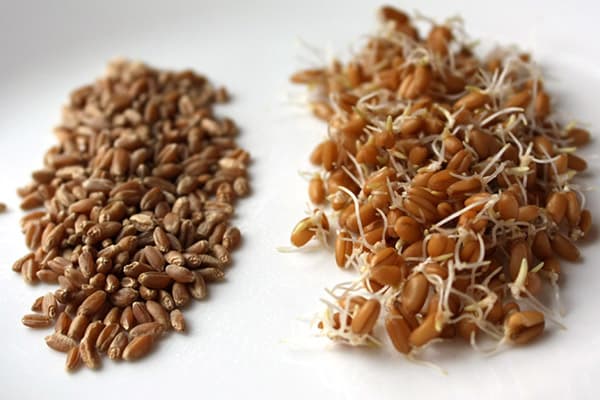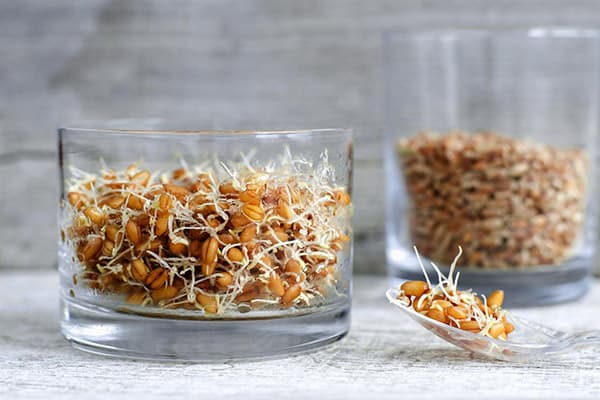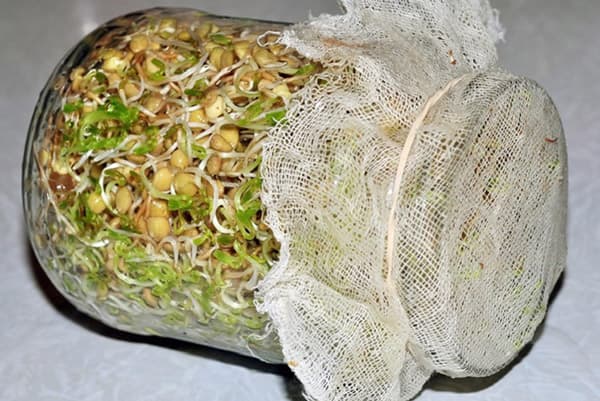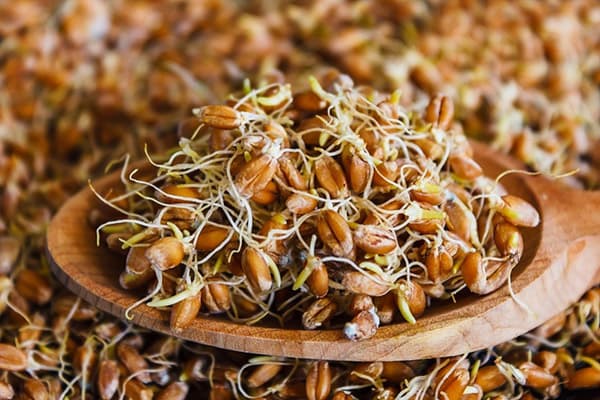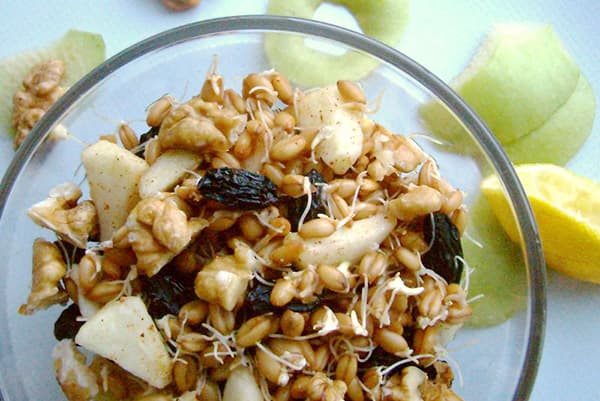2 easy ways to grow wheat seedlings at home
Content:
Germinated cereals and seeds are of great value to human health. For maximum benefit, it is better to sprout the wheat yourself. The smaller the processes, the higher the content of biologically active substances in them. Purchased seedlings are often sold overgrown with long green stems. They are not so nutritious, and they are quite expensive. Fortunately, to foster health and nourish the body with "live" food, it is not necessary to spend fabulous money. It is enough to choose the right grain and soak it for a short time in water.
Which wheat is suitable for germination?
First, it’s worth clarifying that not all wheat is suitable for germination.
- Croup, which lies on the shelves in the store, does not sprout. As well as millet. They are peeled, sanded - that is, damaged.
- The grain that is sold for sowing is not suitable for food: seeds intended for planting are processed with chemicals.
To germinate wheat for food at home, you need to visit a pet store. Yes, yes, it is here that it is easy to find “live” cereals at a very reasonable price. As an alternative, you can consider purchasing grain for germination on the Internet or look for a bag of seeds marked “for sprays” in raw food and vegetarian food stores.
Wheat sprouts do not taste nasty at all. They are sweet, with a touch of flowers and honey, they smell good. After a spoon of sprouted cereals in the mouth there is a smack of gourmet dessert. Many adults and children eat a healthy product with pleasure.
Germination instruction
Wheat along with green buckwheat and sunflower seeds is considered the easiest in terms of germination. It grows very quickly - the whole process from beginning to end takes about 1-2 days.
How to germinate wheat correctly?
- Pour the grains into a container (preferably glass or clay), pour cold water.
- Remove pop-up seeds - they are empty and do not bear any benefit.
- Rub the wheat and drain the water. Rinse it 2-3 times.
- Fill the cereal bowl with clean cold water in a 2: 1 ratio (twice as much water as the grains) and leave to swell in a warm, shaded place.
- After 8-12 hours, rinse the wheat.
- Now the swollen cereals need to be wrapped in gauze, rolled up in 3-4 layers and slightly moistened.
- Every 4–5 hours, it is necessary to rinse the wheat so that it does not sour.
- After 12 hours, the first sprouts will appear. It is recommended to eat them when they reach a size of 0.2–1 cm.
The optimal conditions for the germination of cereals are high humidity, a small draft, light partial shade, and a temperature of 22–26 degrees in the house.
Way for the lazy
In order not to mess with the dishes, you can grow wheat in a half-liter jar:
- Rinse the grain and pour it into a glass jar.
- Add boiled cold water so that it barely covers the wheat.
- Put the rolled gauze over the neck and secure with an elastic band.
- After 8 hours, rinse the swollen grain.
- Pour some water into the saucer and place a jar of wheat down on it (slightly at an angle).
- The seeds will be on gauze and will sprout quickly. Periodically, the jar will need to be filled with water, and then drained to avoid a sour taste.
Do not strive to grow stems. Sprouts longer than 1 cm without soil begin to wither, and the nutritional reserves of the grain will quickly run out. Such grains are best planted in the ground to get young greens.Wheat shoots are rich in chlorophyll, which improves blood composition, normalizes digestion and metabolism.
Germinated wheat can be of 2 types: spouts and vitgrass. The first is grains with sprouts, and the second is green young shoots.
The benefits of sprouted wheat
Germinated seeds and cereals are invaluable to human health. This is a biogenetic product that carries life. Thanks to germination, the minerals in wheat are transformed into a chelate form in which they are firmly bound to amino acids. This allows beneficial substances to be easily absorbed. And there are plenty of them in the grain. These are vitamins of group B (B1, B2, B3, B6, B9), as well as E, A and D. Of the minerals in the seedlings, there is a lot of iron, zinc, phosphorus, potassium.
Sprouts can be eaten by people with gluten intolerance. Germination almost completely neutralizes it, as shown by a study conducted in 2007 by American scientists from the Journal of Agriculture and Food Chemistry.
What is the benefit of wheat germ for the body?
- They improve the condition of the skin and hair.
- Strengthen vision.
- Establish digestion.
- Increase disease resistance.
- They contribute to the rapid emptying of the intestines and the cleansing of the body of toxins and toxins.
- Normalize metabolism.
- Reduce blood cholesterol.
- Contribute to weight loss.
- Improve blood composition.
- Support the work of the nervous and cardiovascular systems, brain, thyroid gland.
The idea of seedlings became widespread in the early twentieth century. First, in 1920, Edmond Zekeli, an American scientist, put forward the concept of bioenergy nutrition and classified wheat germ as a healthy food product. And in 1930, as a result of research by the agricultural chemist Charles Schnabel, the world saw a new “superfood” - ground wheat shoots. The scientist found that chickens eating germinated grains recover faster and rush better. He also introduced the seedlings to the diet of his family, and after some time all its members ceased to be sick. Then Charles patented his discovery and opened the production of seedlings in banks. They were sold in health food stores and were known as Schnabel cans.
Healing properties
Wheat germ does not cure any one particular disease. They affect the whole organism as a whole, establish its work, as a result of which healing occurs.
Eating seedlings is recommended for the following diseases:
- chronic constipation;
- obesity;
- gastritis and other gastrointestinal diseases;
- diabetes;
- oncological diseases;
- hepatitis;
- hypertonic disease;
- avitaminosis;
- anemia;
- frequent colds.
For treatment, it is best to eat germinated grains on an empty stomach, 15 minutes before eating. You need to start with small doses - 1-3 tablespoons per day. Gradually, you can increase the daily volume of eaten seedlings to 5-7 tablespoons.
From germinated grains, you can make masks for the face and hair. To do this, they are passed through a meat grinder and diluted with a small amount of water to the consistency of sour cream.
Eating and storage
After germination, wheat is suitable for eating for about 2 days. Therefore, you do not need to stock up on it for the future. For one person, it’s enough to cook 4-5 tablespoons of cereal. The grains will swell, and just get the norm for 2 days (3 tablespoons per day). Sprouts are stored only in the refrigerator, in a closed container.
It is correct to consume sprouted wheat in raw form, chewing thoroughly and, if necessary, washing down.
Many add sprouts to various dishes:
- vegetable and fruit shakes;
- cereals;
- salads;
- soups.
It is very useful to combine germinated cereals with legumes:
- chickpeas
- lentils
- waving.
Together they have a beneficial effect on the digestive system and are easier to digest. To improve the taste, the seedlings are often mixed with honey, chopped dried fruits, nuts. They are added to bread and pastries, in which they somewhat lose their benefit.
The only thing that can not be consumed with germinated wheat grains is milk. Mixing these two products is fraught with indigestion, flatulence, increased gas formation.
Seedlings are actively used in East Asian cuisine. Especially often they can be found in Chinese dishes. They have been grown here for 3,000 years and are considered the best source of energy and strength.
Sprouting wheat for food is one of the most affordable ways to diversify your diet and nourish your body with healthy substances. Cereals quickly sprout. You need to eat them daily for 1-3 tablespoons per day. Positive properties do not manifest themselves immediately. A noticeable improvement in well-being usually occurs on the 14–21st day of regular intake of seedlings.
